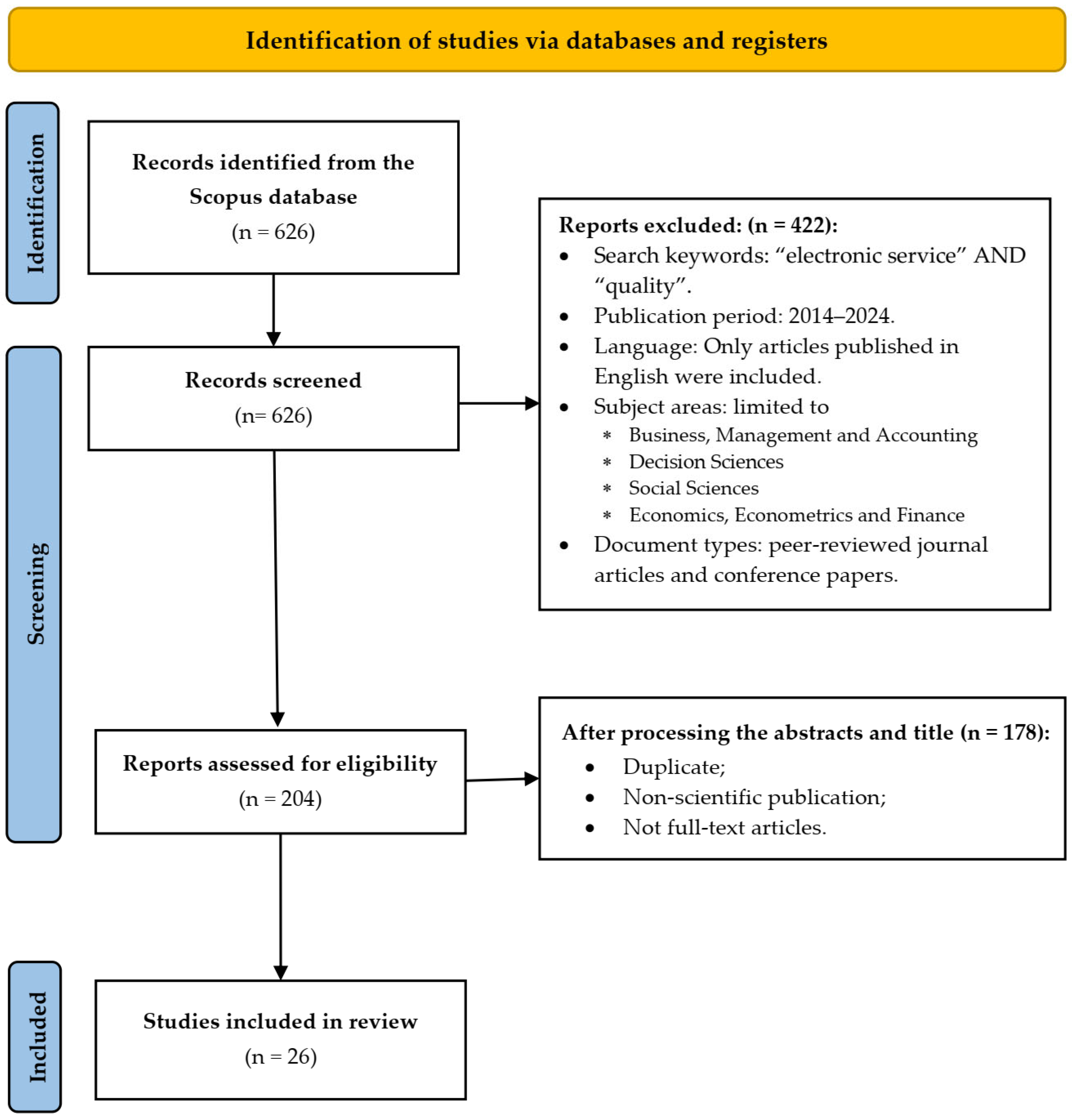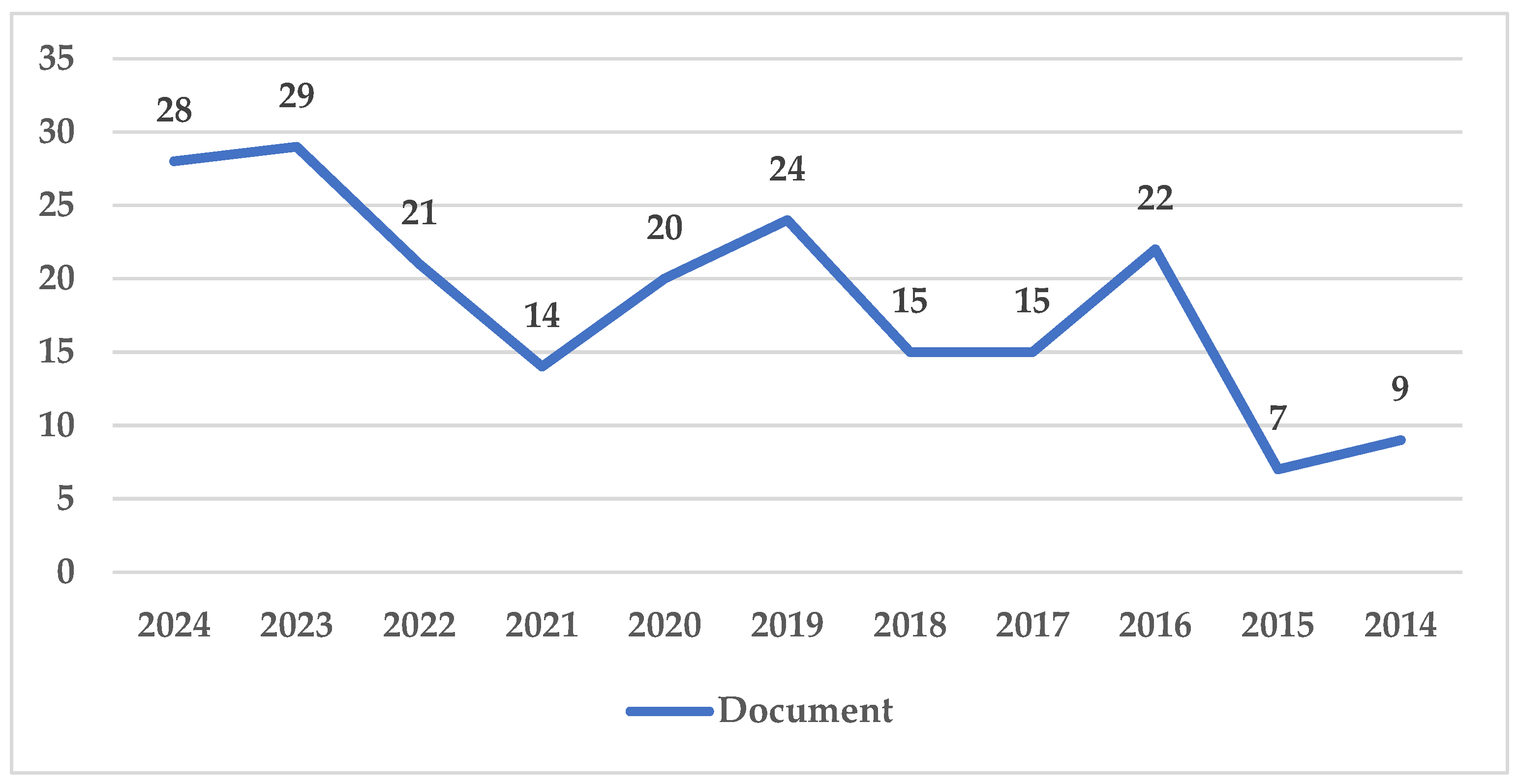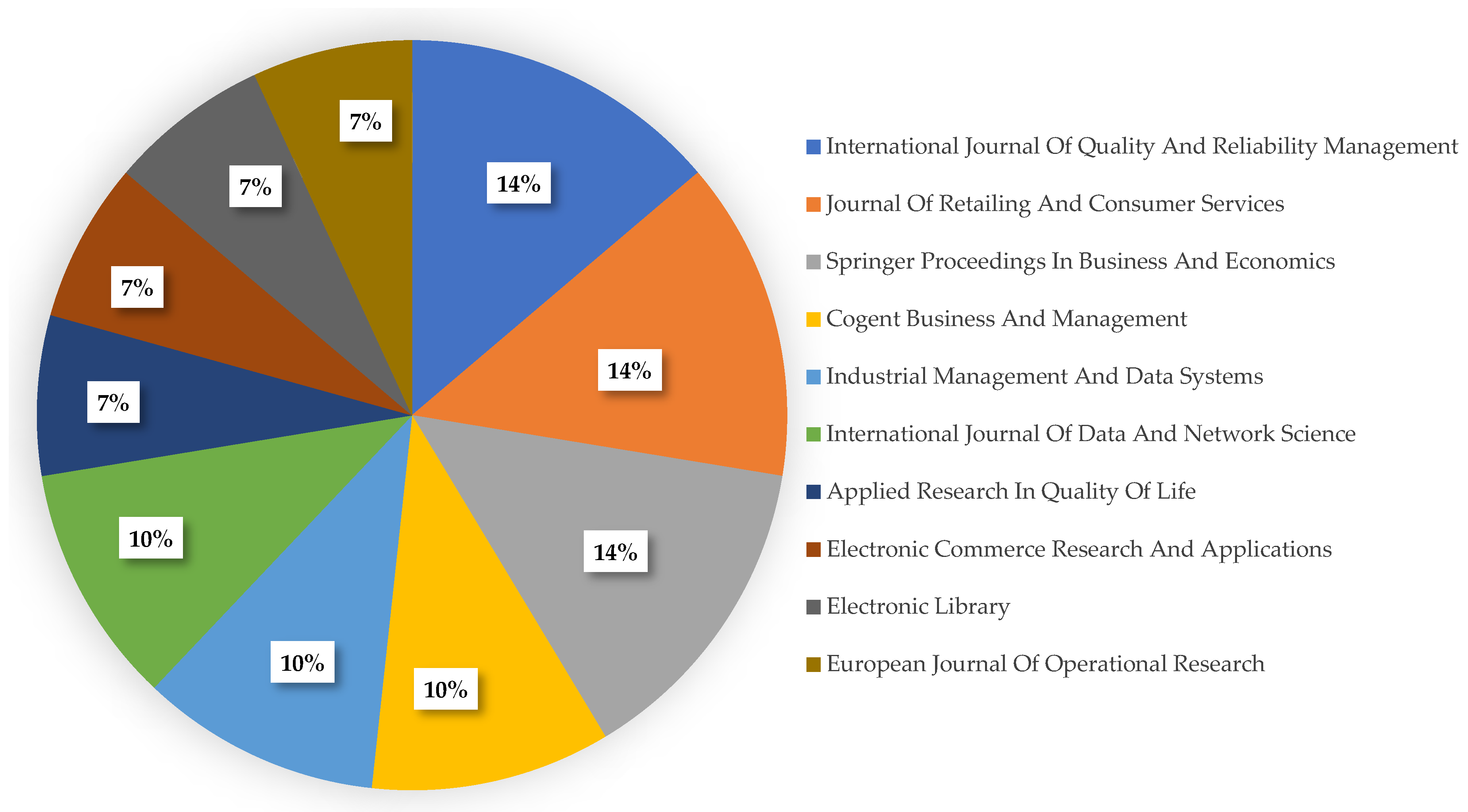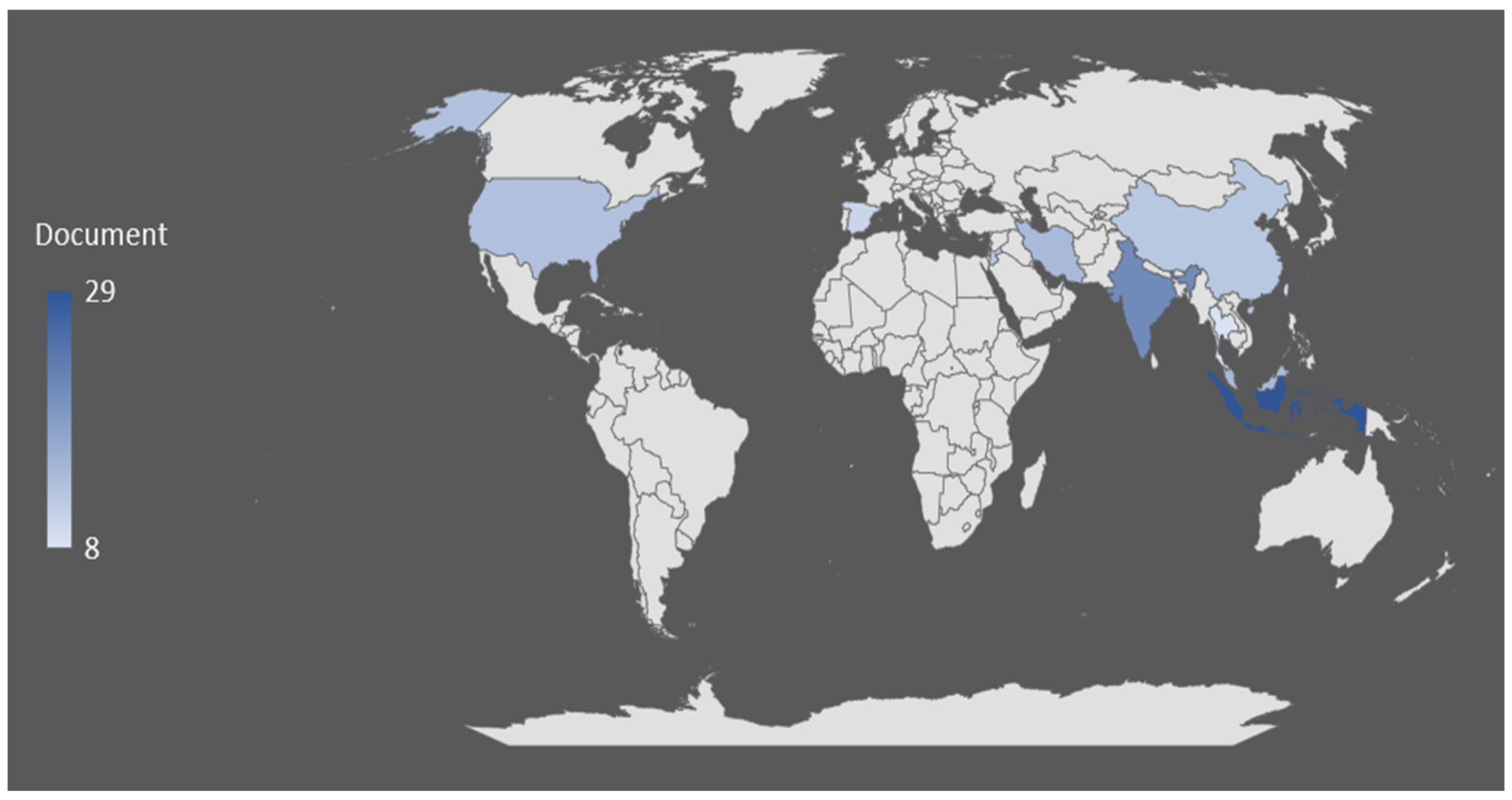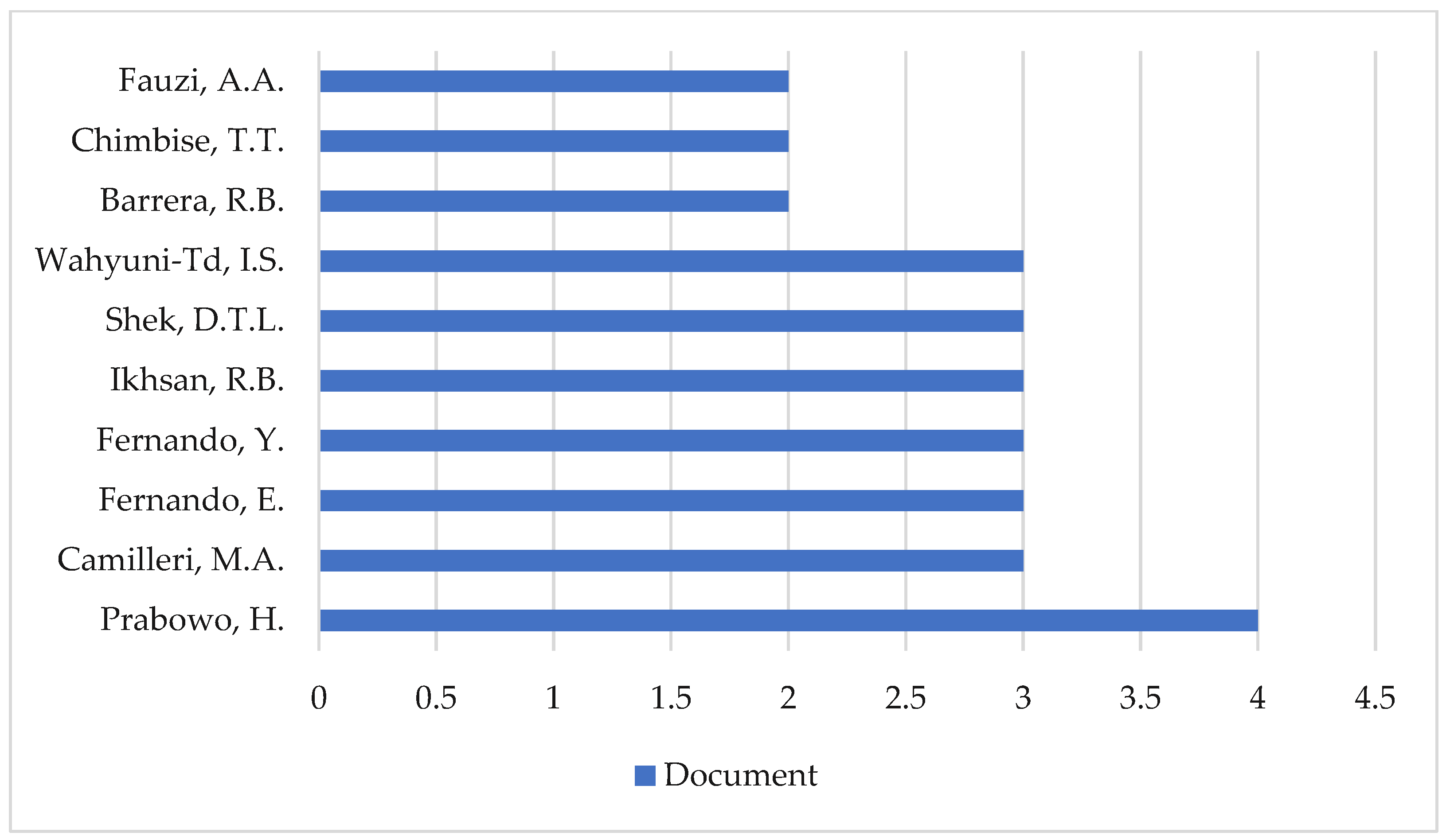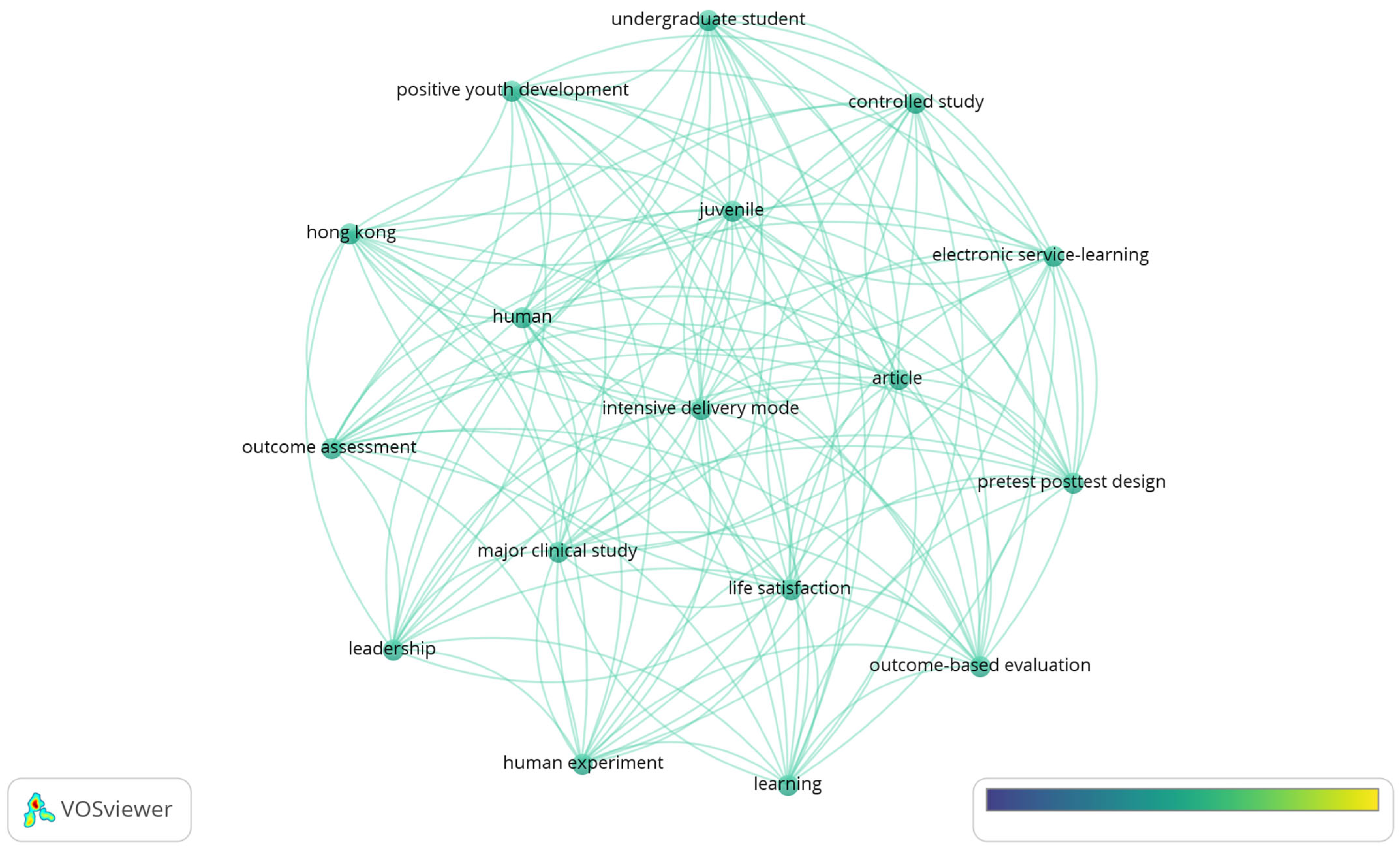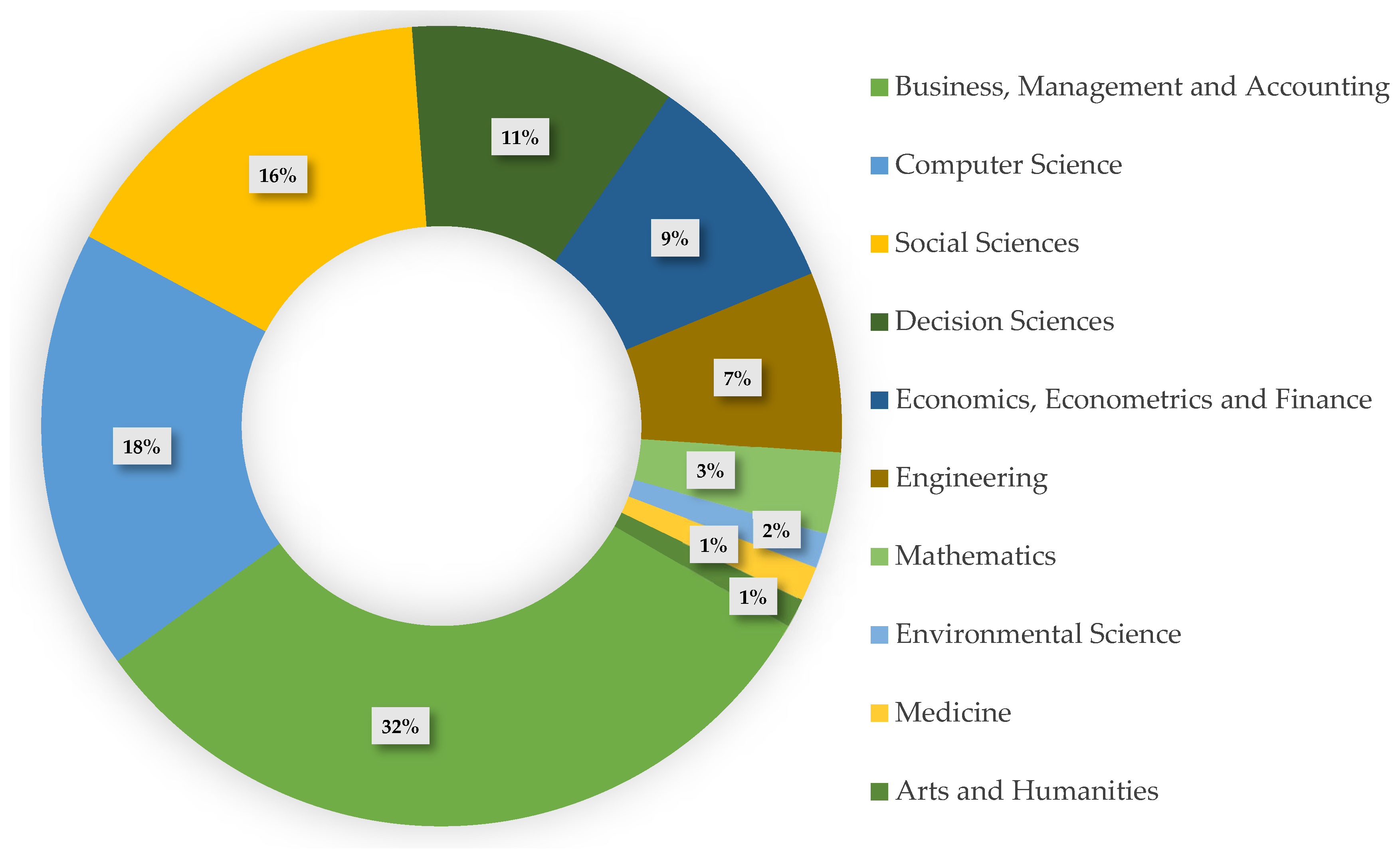1. Introduction
The emergence of e-government, or perhaps more generally the application of information and communication technologies (ICTs) in the government, has transformed the manner in which citizens engage with the government, along with transforming internal administrative procedures and mechanisms (
Carter & Bélanger, 2005;
Im et al., 2014). This has gone beyond technology adoption: e-government has been promoted across the board as a need for modernization, transparency, and effective functioning, and hence it is an imperative and priority research topic in the domains of public administration and information systems (
Belanger & Carter, 2012;
Arduini & Zanfei, 2014). Theoretical advancements in this area of research have grown, providing conceptual frameworks on how digital technologies can shape service provision, enable citizen engagement, and promote institutional innovation. Digital public services are one of the core e-government research themes and are employed to refer to government services provided to citizens and firms in digital form (
Zuiderwijk et al., 2021). Over the past two decades, scholars and practitioners have increasingly examined the potential of these services to build public value, enable accountability, and make administrative processes more rational. Governments across the world have contributed their share by aggressively investing in digital technologies, internet infrastructure, and information systems under the declared aim of improving the performance of the services and addressing greater demands from digitally connected citizens (
MacLean & Titah, 2022). The online services also advance greater confidence among citizens in the state-public institutions since they facilitate direct, transparent, and efficient state-public interactions (
Hsieh et al., 2013;
Alenezi et al., 2015;
Alsarraf et al., 2023). These patterns suggest that technology can be not just an operational tool but also a source of legitimacy and accountability in governance. Despite these theoretical advances, there remains limited empirical work examining the lived experiences of public servants who are involved in providing digital services (
Rana et al., 2015). Most studies have focused on optimizing digital services from the perspective of end-users, with emphasis on system design, user-friendliness, and service quality in the entire digital government transformation process (
Pawlowski & Scholta, 2023). At the same time, governments have also realized the necessity of continuous evaluation of e-government initiatives to ensure effective governance and gain a competitive advantage on the global stage (
Pappel et al., 2019). The necessity arises due to the growing realization that digitalization is no longer a technical problem but a socio-organizational one and requires careful handling of human, institutional, and technological factors.
Digitalization can reduce processing time, enhance transparency, and promote inter-unit collaboration between organizations such that both public service quality and efficiency improve (
Lindgren et al., 2019). However, such developments also create organizational turbulence, producing tension, uncertainty, and even workload overload for employees, particularly when institutional arrangements, job roles, and performance demands are all evolving rapidly at the same time.
These challenges highlight the need to incorporate psychosocial and managerial perspectives into e-government studies in order to understand not only the technological and administrative dimensions but also the human and organizational implications of digitalization. To address this gap and map the current state of knowledge, the present study aims to conduct a large-scale bibliometric analysis of e-government research trends, with the aim of mapping the orientations, priorities, and evolution of the scientific community in this research topic. Emphasis is placed on the most influential works, leading authors, prevalent institutions, and contributing countries. This review thereby tries to provide a balanced overview of the evolution of the field, identify major contributors, and emphasize the networking cooperation that pervades digital governance scholarship.
2. Materials and Methods
This study presents a scoping review designed to map trends in research on the quality in electronic services, with a focus on the major countries, institutions, scientific journals, and contributors involved. The review follows the PRISMA extension for scoping reviews (PRISMAScR) guidelines (
Tricco et al., 2018). To analyze the literature dynamics, we used VOSviewer version 1.6.20 to identify dominant themes, the most influential contributors and recent developments by examining collaboration networks, keyword co-occurrences and institutional output. Given that this is a scoping review, prior registration in PROSPERO or the Open Science Framework was not required.
2.1. Identification
2.1.1. Database Selection
For this study, Scopus was selected as the primary database, with a search strategy completed on 10 April 2025. It was chosen for its exhaustive coverage of peer-reviewed published studies in all disciplines, and for its reliable citation tracking tools (
Baas et al., 2020). As one of the world’s largest and most trusted abstract and citation databases, Scopus enables the reliable identification, analysis, and benchmarking of the world’s scholarly literature, and is therefore ideally suited to the purposes of this review.
2.1.2. Search Strings
To present this study, these keywords were used: “quality AND electronic service for instance, TITLE-ABS-KEY (quality AND electronic AND service). Moreover, publications for the last decade were selected from 2014 to 2024, for instance, PUBYEAR > 2013 AND PUBYEAR < 2025 AND. In addition, the subject area was limited to Business, Management and Accounting, and Decision Sciences and Social Sciences, and Economics, Econometrics and Finance for instance LIMIT-TO (SUBJAREA, “BUSI”) OR LIMIT-TO (SUBJAREA, “DECI”) OR LIMIT-TO (SUBJAREA, “SOCI”) OR LIMIT-TO (SUBJAREA, “ECON”). Publications in English were selected in this review, (LIMIT-TO (LANGUAGE, “English”). Publications were limited to articles and conference paper only, (LIMIT-TO (DOCTYPE, “cp”) OR LIMIT-TO (DOCTYPE, “ar”). journals were the only source in this review, AND LIMIT-TO (SRCTYPE “J”).
Analyzing inclusion and exclusion criteria for our study on electronic service and quality from 2014 to 2024 reveals a focused approach (
Table 1). This timeframe ensures comprehensive coverage while excluding publications outside this range maintains temporal relevance. We prioritize English-language academic journals for consistency and reliability, excluding theses, books, and blogs. Our subsequent analysis will track publication trends, identify emerging themes, and evaluate impact, providing valuable insights for researchers, practitioners, and policymakers in management and economics.
2.2. Screening and Selection
The primary keywords guiding our literature search and analysis were “electronic service” and “quality”. The initial search yielded 626 documents. After applying the criteria for inclusion and exclusion, 204 publications were retained for final analysis, while 422 were excluded (
Figure 1).
To carry out this analysis, the researchers asked the following questions:
What is the distribution of publications on electronic service and quality during the years 2014–2024?
What are the most relevant journals for research on electronic service and quality?
Which countries are the most influential in the field of research on electronic service and quality?
What are the most important educational institutions in the field of electronic service and quality research?
Who are the most prolific authors in the field of research on electronic service and quality?
What are the main search keywords on electronic service and quality?
2.3. Inclusion and Reporting
The results of this bibliometric analysis will be presented in accordance with the PRISMA Framework (
Page et al., 2021).
3. Results
This section explores the findings of bibliometric analysis, looking particularly at the relationship between electronic service and quality. Spanning a decade of research, the study offers meaningful insights into the evolution of this dynamic field. It explores key themes such as dominant subject areas, publication trends, leading journals and countries, influential academic institutions, prolific authors, and recurring research keywords. The aim of this synthesis is to trace the development of electronic services in relation to quality, while identifying the main factors that facilitate or hinder these processes within organizational contexts. The findings offer essential direction for corporations and public officials aiming to improve service quality and utilize electronic services to sustain a competitive advantage in a rapidly evolving digital marketplace.
3.1. Distribution by Years
This study explores the publication landscape on electronic service and quality from 2014 to 2024. It examines research trends over the past decade to identify shifts in scholarly focus and emerging areas of interest. The analysis also delves into the thematic domains and methodological approaches adopted in the literature, offering insights into the dominant concerns of the academic community. By providing a detailed overview of the current state of research, this study aims to highlight key developments and propose potential directions for future investigations.
Figure 2 illustrates the distribution of publications on electronic service and quality from 2014 to 2024. There is a notable increase in the number of documents, rising from 14 in 2021 to 28 in 2024. This indicates a significant rise in interest regarding the integration of electronic service and quality of service in academic research. The lowest number of documents was recorded in 2015, with only 7 publications, while the highest was in 2023 with 29 publications.
The distribution of publications on electronic service and quality from 2014 to 2024 according to total publications of relevant journals is shown in
Figure 3.
3.2. Most Relevant Journals
In analyzing these academic journals, several trends and characteristics have emerged. Journal of Retailing and Consumer Services stands out with an impressive number of publications (1578) and a substantial citation total (35,678), reflecting its strong influence and visibility in the field of electronic service and quality. European Journal of Operational Research, with 2586 publications and 34,015 citations, and Electronic Commerce Research and Applications, with 375 publications and 4077 citations, are also important players, illustrating the diversity of information sources and perspectives in this field. The most cited articles reveal important themes and emerging research trends. For example, the most cited article in Journal of Retailing and Consumer Services is entitled “Artificial intelligence-generated virtual influencer: Examining the effects of emotional display on user engagement”. Similarly, the most cited article in European Journal of Operational Research is “The flexible job shop scheduling problem: A review”. Furthermore, the diversity of publishers, ranging from Emerald Publishing to Springer Nature and Elsevier, underlines the variety of perspectives and editorial approaches in the field. These observations suggest a dynamic and evolving academic landscape in the study of electronic service and quality, highlighting the growing importance of interdisciplinary research and collaboration between researchers and practitioners (
Table 2).
3.3. Most Significant Countries
In addressing the third research question, “Which countries are the most influential in the field of research on electronic service and quality?”, an analysis of the data under study reveals a heterogeneous worldwide impact, as seen in
Table 3,
Figure 4 and
Figure 5.
The most productive countries in this field are Indonesia (29 publications), India (21 publications), and Iran (14 publications). These three countries are also among the global leaders in digital innovation and the development of electronic services. They have made significant investments in research and training related to this domain, particularly in enhancing service quality across various sectors. Following them in the ranking are Malaysia (14 publications), the United States (13 publications), China (12 publications), and Jordan (12 publications). Although to a slightly lesser extent, these countries also exhibit strong activity in the field of electronic service research and innovation. Their efforts focus on improving user experience, responsiveness, and operational efficiency through the implementation of high-quality digital service. The least productive countries in this area are Spain (10 publications), Taiwan (9 publications), and Thailand (8 publications).
3.4. Most Significant Educational Institutions in Electronic Service and Quality Research Area
Research on electronic service and quality has garnered significant attention from academic institutions across the globe (
Table 4).
Among the most active contributors in this field, Bina Nusantara University stands out with a total of 9 publications, highlighting both its commitment and its growing expertise in exploring the intersection of technology and service quality. Following closely is the University of Isfahan, with 5 scholarly articles, reflecting its sustained engagement in the development of knowledge surrounding digital service delivery and its impact on quality standards. The Hong Kong Polytechnic University also makes a notable contribution with 4 publications, reinforcing its position as a key player in this area of research. In addition, several other institutions have demonstrated consistent interest and participation in the academic discourse on electronic services and quality. These include The University of Edinburgh, Universidad de Sevilla, Al-Balqa Applied University, Universitas Andalas, L-Università ta’ Malta, Telkom University, and INTI International University, each of which has produced 3 articles. Their collective output not only reflects their dedication to advancing research in this dynamic domain but also contributes to the global understanding of how electronic service innovations can enhance quality outcomes across various organizational and sectoral contexts.
3.5. Most Prolific Authors
The fifth research question seeks to identify authors with the most significant contributions in the field of electronic service and quality (
Table 5).
The analysis of the bibliometric data highlights the global diversity and scholarly depth of researchers who have significantly contributed to the field of electronic services and quality (
Figure 6). Among the most prominent scholars is Shek, D. T. L. from The Hong Kong Polytechnic University, whose impressive academic record includes 1158 publications, an H-index of 72, and a total of 21,678 citations since 1996. His extensive body of work and sustained influence underscore his pivotal role in shaping discourse in technology-enabled service research and quality evaluation. Another noteworthy contributor is Camilleri, Mark A., affiliated with L-Università ta’ Malta. Since 2014, he has produced 146 publications, achieved an H-index of 37, and accumulated 3885 citations. His research reflects a strong and consistent focus on the digital transformation of services, with a particular emphasis on how innovation and technology intersect with quality management and strategic service delivery. Equally significant is the contribution of Fernando, Yudi from Universiti Malaysia Pahang Al-Sultan Abdullah in Malaysia. Since 2009, he has authored 165 publications, reached an H-index of 29, and garnered 3760 citations. His work illustrates a solid commitment to exploring how electronic service solutions can enhance operational efficiency and customer satisfaction, particularly within the context of emerging economies. Collectively, these researchers exemplify the high level of academic engagement and international collaboration that characterize the field of electronic services and quality. Their individual accomplishments not only reflect scholarly excellence but also contribute meaningfully to the advancement of knowledge in this evolving domain.
3.6. Primary Research Keywords and Trends
In response to the sixth inquiry about the most prominent research terms and keywords concerning electronic service and quality.
The keywords in
Figure 7 are indicated by default with circles. The larger the circle, the more significant the element. Additionally, colors are assigned to each group of elements, naming them as clusters. At first glance, the map highlights electronic service and electronic service quality as central concerns, as they serve as key concepts from which most authors commence their research. Overall, we have 17 items, 1 cluster, 136 links.
The keywords in
Figure 8 are indicated by default with circles. The larger the circle, the more significant the element. Additionally, colors are assigned to each group of elements, naming them as clusters. At first glance, the map highlights electronic service quality as a central concern, Overall, we have 13 items, 2 clusters, 51 links.
3.7. Most Important Subject Area
To address the seventh research question “which subject area is the most critical in terms of electronic service and quality”,
Figure 9 provides the details.
Analysis of the data indicates that the majority of publications related to electronic service and quality are concentrated in the field of Business, Management, and Accounting (34.7%), reflecting the central role of service quality in strategic management and organizational performance. This is followed by Computer Science (19.5%) and Social Sciences (17.5%), which highlight the interdisciplinary nature of the topic, combining technological innovation with human and societal dimensions. Decision Sciences (11.8%) and Economics, Econometrics, and Finance (10.0%) also demonstrate notable engagement, suggesting a growing interest in data-driven decision-making and the economic evaluation of electronic services. Fields such as Engineering (8.0%), Mathematics (3.6%), and Environmental Science or Medicine (each 1.5%) show more modest representation, while Arts and Humanities (1.3%) remains the least explored. This low representation can be explained by the traditional focus of Arts and Humanities on cultural, ethical, and philosophical perspectives rather than on technology-driven services. However, this domain offers promising opportunities for development, particularly by exploring how digital and electronic services reshape human experiences, cultural practices, communication, and ethical considerations. Encouraging interdisciplinary research that bridges technology with humanistic perspectives could significantly enrich the understanding of e-services and broaden the scope of future studies.
4. Discussion
The bibliometric analysis of research over the past decade highlights a steady and significant increase in studies examining the relationship between electronic services and service quality, underscoring the growing importance of digital technologies in reshaping service delivery models across sectors, including the public domain. This acceleration in scholarly output, particularly from 2020 and beyond, is in line with the global acceleration of digitalization being driven by mass technology adoption, the rise in demand for online services, and the heightened emphasis on ensuring quality of service in cyberspace amid the COVID-19 outbreak. In the context of e-government, this digital change has a dual dynamic: an ambitious aspiration to leverage technology to transform public services, and a limited view regarding the human and organizational aspects involved in doing so. E-government, in essence, refers to the development of electronic systems and the application of information and communication technologies to enhance public service delivery to citizens (
Aleisa, 2024).
Earlier e-government studies were predominantly focused on the delivery of services (
Reece, 2006;
Dawes, 2009), whereas the field has become increasingly focused on more systematic, quantitative, and interdisciplinary research since approximately the mid-2000s. Despite such evolution, however, most research remains concentrated on adoption, usage, or citizen satisfaction with digital services (
Wirtz & Daiser, 2018), with critical domains like internal human resources, interpersonal relationships in public organizations, and organizational complexities due to digitalization comparatively under-researched. Since user interaction in the long run is essential for information system success, future behavioral studies need to investigate more usage patterns, particularly long-term interaction.
Moreover, variations in e-government service types and adoption determinants among vulnerable populations remain worthwhile yet lesser-researched topics (
Rosenberg, 2024). This interdisciplinary focus of e-government research is illustrated by the inclusion of contributions from high-tier journals such as the Journal of Retailing and Consumer Services and the European Journal of Operational Research. This has made it possible to integrate perspectives from management, information systems, operations research, and social sciences, enriching both conceptual foundations and methodological techniques employed to evaluate and enhance digital service quality. Thus, user attitudes and behavior must be examined together with different types of public services and portals in order to present more intricate information. However, the use of online services is faced with a range of challenges. Low levels of societal participation and low rates of adoption are frequently stated as challenges to productive e-government deployment (
Glyptis et al., 2020). Economic contributions from the emerging economies of Indonesia, India, and Iran demonstrate a transformation from Western-oriented research paradigms to non-Western dominance in digital innovation and e-service adoption. Such contexts tend to apply quality management practices in adapting to localized socio-economic and organizational realities. Yet, such hopes are vulnerable to working environments of civil servants, who must contend with heightened expectations, rapid organizational changes, and restructuring, normally in contexts of inadequate support or challenging managerial environments. Research has also indicated the role of citizen attitudes, particularly trust and satisfaction, in constructing loyalty in digital government services (
Alkraiji & Ameen, 2022). The quality of public digital services must be assessed by more sophisticated techniques than those commonly applied in business environments. These traditional instruments, like SERVQUAL or e-SERVQUAL, become useful in the commercial context but do not operate completely in the context of services aimed at reaching the public good rather than profit (
Pham et al., 2023).
Shareef et al. (
2015) offer a critical extension of e-government service quality measurement, identifying five dimensions—ease of interaction, fulfillment, security and privacy, citizen attention, and reliability—that more suitably describe the character of digital public services. Beyond these paradigms, the broader field of electronic service quality is unfolding, as evidenced by the ubiquity of phrases such as “electronic service quality,” “user experience,” and “operational efficiency,” and embryonic fields such as artificial intelligence in service delivery, user-personalized experiences, and constructing increased trust in digital spaces. This development signifies a mature research landscape with international cooperation being extremely strong, methodological and theoretical diversity, and managerial focus on the utilization of online services for the generation of tangible value for service providers and users. Not only does it enrich scholarly understanding, but it also provides practical guidance for practitioners attempting to balance technological innovation with human and organizational needs, thereby providing equitable access, sustainable outcomes, and improved user experiences in an increasingly digital and frenetic world.
The bibliometric evidence reveals a considerable rise in research on electronic services and their quality, particularly since 2020, confirming the increased interest of the scientific community in digitalization and its effects. The pattern is in line with the broader literature on the importance of trust, user experience, and perceived quality for the adoption and sustained use of digital public services. However, gaps in human, organizational, and contextual elements persist continuously, particularly in developing countries.
5. Conclusions
The success of a fair and sustainable e-government relies on dual orientation: technological and human. While digital tools offer promising avenues for rapid modernization, their long-term effectiveness largely depends on organizational policies that are people-centered, attentive to psychosocial risks, and capable of strengthening the resources of public employees. Well-supported, valued, and resilient staff are not only more willing to engage in digital innovation but also contribute to enhancing service quality and fostering innovation. This balance between technological innovation and organizational empathy is particularly crucial in developing countries, where public administrations often operate with limited resources under strong social pressure. Investing in the well-being of civil servants is therefore not a luxury but a strategic necessity for strengthening trust and institutional capacity. However, despite this major challenge, research on e-government still presents several shortcomings. The human dimension remains underexplored, with most studies focusing on adoption and citizen satisfaction at the expense of employees’ internal experience. Few integrative models coherently combine technological, organizational, and human dimensions. Quality measurement tools, often derived from the private sector, appear limited in capturing the specificity of public services. Furthermore, scientific production remains geographically imbalanced, with a strong concentration of studies in Asia and under-representation of Europe, Africa, and Latin America. Finally, emerging themes such as e-trust, digital inclusion, sustainability, artificial intelligence, and blockchain remain insufficiently explored. Thus, the future of e-government requires both stronger consideration of the human factor in public policies and a deeper, integrative, and interdisciplinary scientific approach to ensure a digital transformation that is not only effective but also socially responsible, fair, and sustainable.
6. Limitations and Perspectives
There are some limitations of this study that need to be highlighted. Firstly, reliance on a single database (Scopus) may have resulted in a database bias because articles published in other databases, such as Web of Science, that were not covered may have been relevant. Nonetheless, Scopus was intentionally selected because of the breadth, reliability, and high standards of indexing within the field of management, economics, and technology to cover up similarities and quality within the data. Subsequent research can include additional databases such as Web of Science, Dimensions, or Lens to enhance findings to be more robust and comprehensive. Second, using only English-language literature may have diminished the global representativeness of the results by excluding influential studies in other languages. While a concentration on English ensured comparability and captured most of the internationally known output, later research could consider multilingual analyses to better reflect global perspectives. Third, the research might have been skewed by citation lag effects, whereby more recent research has not yet acquired citations, potentially resulting in an underestimation of its academic impact. This study attempted to get around this by including publications through 2024, so contemporary trends would be discerned through keyword and authorship trends, but subsequent work may use longitudinal citation analysis to more sensitively pick up evolving impact. Fourth, the presence of self-citation patterns may have influenced author-level measures, lightly inflating productivity or scholarly influence. Finally, whereas the current research grounded its analyses upon firm bibliometric foundations, it did not include qualitative or interdisciplinary analyses that could further augment contextual insight. Subsequent studies could combine bibliometric analysis with systematic qualitative syntheses or comparative case studies on the experiences of civil servants implementing e-government projects. Research on these new topics as e-trust, digital inclusion, organizational justice in cyberspace, and a role for artificial intelligence or blockchain to ensure service quality, would bring together management, psychology, communications, and political science insight to provide a more complete and multidisciplinary image of this dynamic field.
Author Contributions
Conceptualization, O.Y. and O.B.; methodology, O.Y. and O.B.; software, O.Y., N.S., I.I. and O.B.; validation, O.Y. and O.B.; data curation, O.Y.; formal analysis, O.Y.; resources, O.Y., Y.E.G., N.S. and I.I.; writing-original draft preparation, O.Y., Y.E.G., N.S., I.I. and O.B.; writing—review and editing, O.Y., Y.E.G. and O.B.; visualization, O.Y., Y.E.G. and O.B.; project administration, O.B.; supervision, O.B. All authors have read and agreed to the published version of the manuscript.
Funding
This research received no external funding.
Institutional Review Board Statement
Not applicable.
Informed Consent Statement
Not applicable.
Data Availability Statement
The raw data supporting the conclusions of this article will be made available by the authors on request.
Conflicts of Interest
The authors declare no conflicts of interest.
References
- Aleisa, N. (2024). Key factors influencing the e-government adoption: A systematic literature review. Journal of Innovative Digital Transformation, 1(1), 14–31. [Google Scholar] [CrossRef]
- Alenezi, H., Tarhini, A., & Sharma, S. K. (2015). Development of quantitative model to investigate the strategic relationship between information quality and e-government benefits. Transforming Government: People, Process and Policy, 9(3), 324–351. [Google Scholar] [CrossRef]
- Alkraiji, A., & Ameen, N. (2022). The impact of service quality, trust and satisfaction on young citizen loyalty towards government e-services. Information Technology & People, 35(4), 1239–1270. [Google Scholar] [CrossRef]
- Alsarraf, H. A., Aljazzaf, S., & Ashkanani, A. M. (2023). Do you see my effort? An investigation of the relationship between e-government service quality and trust in government. Transforming Government: People, Process and Policy, 17(1), 116–133. [Google Scholar] [CrossRef]
- Arduini, D., & Zanfei, A. (2014). An overview of scholarly research on public e-services? A meta-analysis of the literature. Telecommunications Policy, 38(5–6), 476–495. [Google Scholar] [CrossRef]
- Baas, J., Schotten, M., Plume, A., Côté, G., & Karimi, R. (2020). Scopus as a curated, high-quality bibliometric data source for academic research in quantitative science studies. Quantitative Science Studies, 1(1), 377–386. [Google Scholar] [CrossRef]
- Belanger, F., & Carter, L. (2012). Digitizing government interactions with constituents: An historical review of e-government research in information systems. Journal of the Association for Information Systems, 13(5), 363–394. [Google Scholar] [CrossRef]
- Carter, L., & Bélanger, F. (2005). The utilization of e-government services: Citizen trust, innovation and acceptance factors. Information Systems Journal, 15(1), 5–25. [Google Scholar] [CrossRef]
- Dawes, S. S. (2009). Governance in the digital age: A research and action framework for an uncertain future. Government Information Quarterly, 26(2), 257–264. [Google Scholar] [CrossRef]
- Glyptis, L., Christofi, M., Vrontis, D., Del Giudice, M., Dimitriou, S., & Michael, P. (2020). E-Government implementation challenges in small countries: The project manager’s perspective. Technological Forecasting and Social Change, 152, 119880. [Google Scholar] [CrossRef]
- Hsieh, P. H., Huang, C. S., & Yen, D. C. (2013). Assessing web services of emerging economies in an Eastern country—Taiwan’s e-government. Government Information Quarterly, 30(3), 267–276. [Google Scholar] [CrossRef]
- Im, T., Cho, W., Porumbescu, G., & Park, J. (2014). Internet, trust in government, and citizen compliance. Journal of Public Administration Research and Theory, 24(3), 741–763. [Google Scholar] [CrossRef]
- Lindgren, I., Madsen, C. Ø., Hofmann, S., & Melin, U. (2019). Close encounters of the digital kind: A research agenda for the digitalization of public services. Government Information Quarterly, 36(3), 427–436. [Google Scholar] [CrossRef]
- MacLean, D., & Titah, R. (2022). A systematic literature review of empirical research on the impacts of e-government: A public value perspective. Public Administration Review, 82(1), 23–38. [Google Scholar] [CrossRef]
- Page, M. J., McKenzie, J. E., Bossuyt, P. M., Boutron, I., Hoffmann, T. C., Mulrow, C. D., Shamseer, L., Tetzlaff, J. M., Akl, E. A., Brennan, S. E., & Chou, R. (2021). The PRISMA 2020 statement: An updated guideline for reporting systematic reviews. BMJ, 372, n71. [Google Scholar] [CrossRef] [PubMed]
- Pappel, I., Tsap, V., & Draheim, D. (2019). The e-LocGov model for introducing e-Governance into local governments: An Estonian case study. IEEE Transactions on Emerging Topics in Computing, 9(2), 597–611. [Google Scholar] [CrossRef]
- Pawlowski, C., & Scholta, H. (2023). A taxonomy for proactive public services. Government Information Quarterly, 40(1), 101780. [Google Scholar] [CrossRef]
- Pham, L., Limbu, Y. B., Le, M. T. T., & Nguyen, N. L. (2023). E-government service quality, perceived value, satisfaction, and loyalty: Evidence from a newly emerging country. Journal of Public Policy, 43(4), 812–833. [Google Scholar] [CrossRef]
- Rana, N. P., Dwivedi, Y. K., & Williams, M. D. (2015). A meta-analysis of existing research on citizen adoption of e-government. Information Systems Frontiers, 17(3), 547–563. [Google Scholar] [CrossRef]
- Reece, B. (2006). E-government literature review. Journal of E-Government, 3(1), 69–110. [Google Scholar] [CrossRef]
- Rosenberg, D. (2024). Older adults’ e-government use for bureaucratic and transactional purposes: The role of website-related perceptions and subjective digital skills. Transforming Government: People, Process and Policy, 18(2), 257–269. [Google Scholar] [CrossRef]
- Shareef, M. A., Archer, N., & Dwivedi, Y. K. (2015). An empirical investigation of electronic government service quality: From the demand-side stakeholder perspective. Total Quality Management & Business Excellence, 26(3–4), 339–354. [Google Scholar] [CrossRef]
- Tricco, A. C., Lillie, E., Zarin, W., O’Brien, K. K., Colquhoun, H., Levac, D., Moher, D., Peters, M. D., Horsley, T., Weeks, L., & Hempel, S. (2018). PRISMA extension for scoping reviews (PRISMA-ScR): Checklist and explanation. Annals of Internal Medicine, 169(7), 467–473. [Google Scholar] [CrossRef] [PubMed]
- Wirtz, B. W., & Daiser, P. (2018). A meta-analysis of empirical e-government research and its future research implications. International Review of Administrative Sciences, 84(1), 144–163. [Google Scholar] [CrossRef]
- Zuiderwijk, A., Chen, Y. C., & Salem, F. (2021). Implications of the use of artificial intelligence in public governance: A systematic literature review and a research agenda. Government Information Quarterly, 38(3), 101577. [Google Scholar] [CrossRef]
| Disclaimer/Publisher’s Note: The statements, opinions and data contained in all publications are solely those of the individual author(s) and contributor(s) and not of MDPI and/or the editor(s). MDPI and/or the editor(s) disclaim responsibility for any injury to people or property resulting from any ideas, methods, instructions or products referred to in the content. |
© 2025 by the authors. Licensee MDPI, Basel, Switzerland. This article is an open access article distributed under the terms and conditions of the Creative Commons Attribution (CC BY) license (https://creativecommons.org/licenses/by/4.0/).
